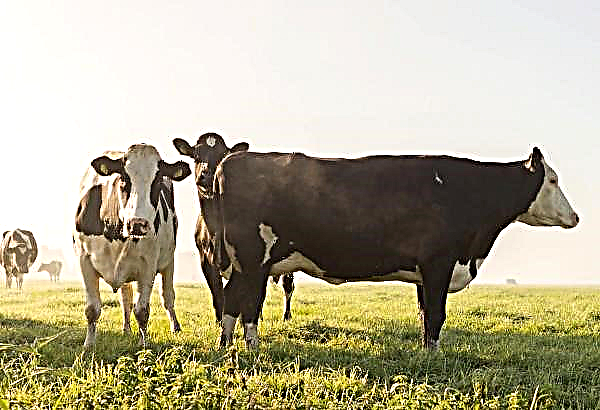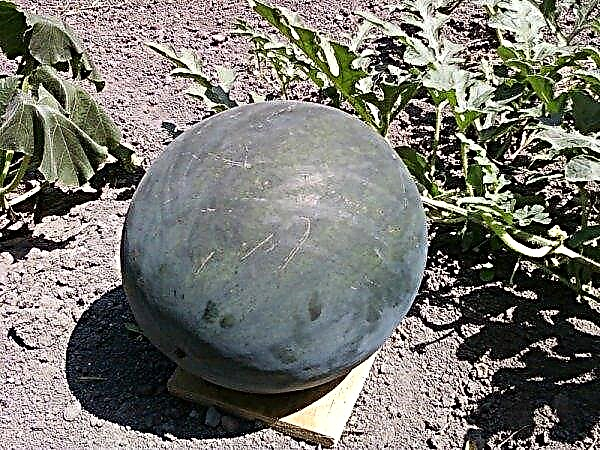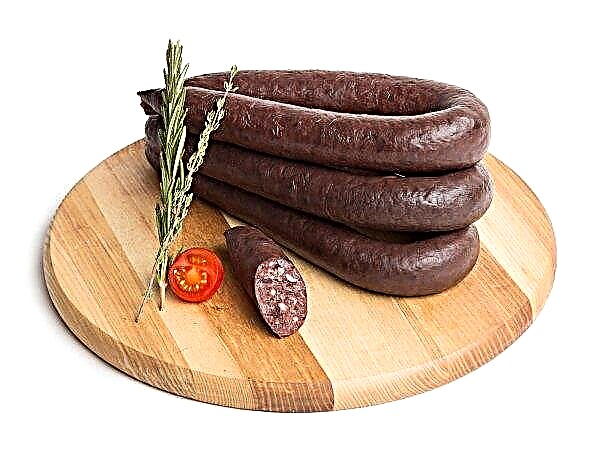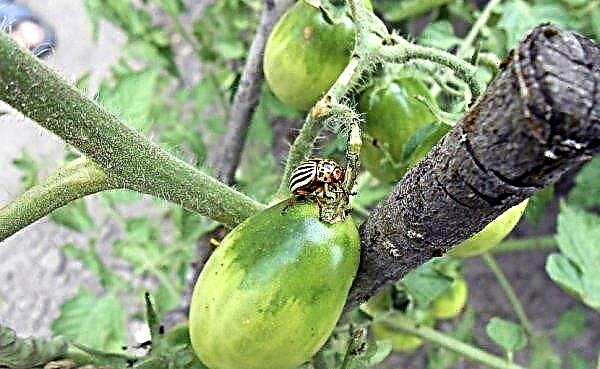Poultry can be kept in 2 ways: outdoor and cellular. In the material we will talk about the features of the second option. You will find out what its advantages and disadvantages are, what are the requirements for cages, what conditions should be in them, and how to care for birds.
Cell content of chickens
This method has mixed reviews. On the one hand, it allows you to save space and time for cleaning. On the other hand, it causes discomfort to birds that cannot move normally and must put up with living in a small area.
Important! In the cells, as a rule, they contain chickens that belong to the egg or meat-egg direction. Meat is not suitable for such a stay, because in the absence of daily walks, they form lower meat in taste and quality.
Pros
- The advantages of the cellular method of maintenance include:
- the possibility of placing in a small area a large number of layers - per 1 sq. km. m can contain up to 10 individuals, while with the floor content it is recommended not to exceed the number of individuals in 5-6;
- simplification and acceleration of the implementation of care measures - cleaning and processing with disinfectants;
- the use of less feed - because chickens do not have the ability to rake food from the feeder and trample it;
- easier egg collection process - special egg collectors are used;
- stable egg production throughout the year;
- safety of birds and eggs - in cages they are protected from small rodents and predators;
- the opportunity for the owner to fully control the conditions in which the birds live.
Minuses
- Among the minuses of living poultry in a cellular way should be noted:
- Significant financial investments in the purchase of equipment and care for it - for keeping less than 500 heads, this method is economically disadvantageous;
- lack of comfort for birds - in European countries the cellular content was recognized as inhumane and gradually abandon it;
- feeding with expensive compound feeds, premixes, vitamin supplements to replenish the body with the missing vitamins and minerals;
- lower meat quality compared to floor content;
- an increase in the costs of the prevention and treatment of diseases, since with this content the chickens are more often sick;
- trauma to the paws when cell selection is unsuccessful;
- insufficient lighting;
- short lifespan.
Did you know? Chickens make about 30 sounds that they use to communicate with each other. In the “chicken” language there are sounds signaling the approach of danger, the proximity of food, a laid egg, sympathy for a rooster, etc.
How to choose a chicken cage
Cages for poultry can be made with your own hands or purchased ready-made. They are a rectangular box with a floor and a front wall made of mesh, a floor tilted at an angle of 7-10 degrees and gutters for rolling eggs. At the bottom of the cage is a litter tray. It is desirable that the roof be removable - it is so convenient to remove the birds if necessary, to clean and disinfect the box.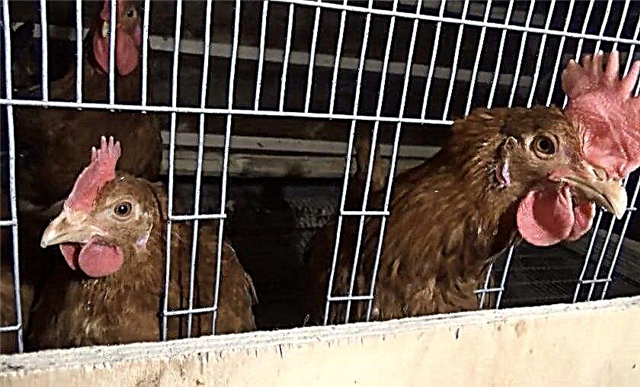 When choosing, you need to pay attention to such nuances:
When choosing, you need to pay attention to such nuances:
- Strength - rods and walls should be made of materials that the chicken cannot penetrate or damage with its beak; the floor must support the weight of the bird.
- Safety - all fasteners must be hidden in a reliable manner, not contain barbs, sharp areas that the bird could get hurt.
- Environmental friendliness - since chickens and their eggs are eaten by humans, their homes should not contain substances that can adversely affect both the birds themselves and the human body (usually cells are made of wood and metal profiles).
- Durability - the materials from which the cell is made must serve for a long time.
- Convenience when using, cleaning and collecting eggs.
- Convenience when feeding and pouring water.
- Cell sizes - they must be such that the layer cannot get stuck in them.
- The presence of artificial lighting.
- Removable drinkers and feeders - cages can be sold complete with equipment for drinking and feeding, it should be easily removed for washing and processing with disinfectants.
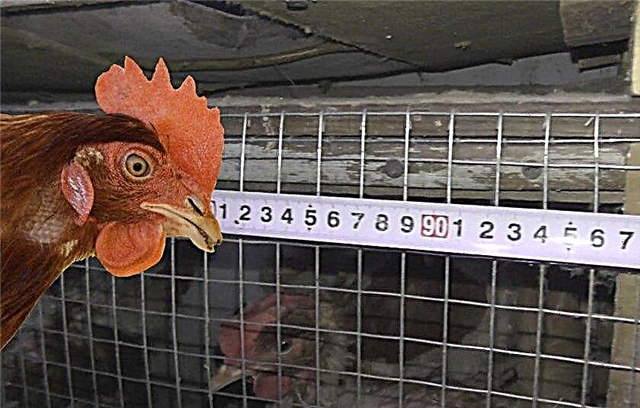
The best breeds of chickens for cage
If you plan to resort to the cell placement of chickens, then you need to take care of the acquisition of breeds that are most suitable for such a residence. Which birds are best suited for life in cells can be found in the list:
- broken brown;
- leggorn;
- Highsex Brown;
- Kuchinskaya.
Important! All of the listed egg breeds are capable of showing high productivity only with good nutrition, clean living conditions, and proper lighting. Errors in these parameters threaten low egg production.
Cell requirements
There are certain requirements for the size, climatic parameters and lighting of bird houses.
Dimensions
As we have already noted, cells can be purchased, with standard sizes or made with your own hands. The main size requirement is the ability to comply with the recommended fit. Standard cells, where 5 individuals can be accommodated, usually have a length of 1–1.4 m, a width of 0.5–0.7 m, and a height of 0.7 m. For 10 individuals, a dwelling with minimum dimensions is required: length - 2 m , width - 1 m, height - 0.7 m. These parameters will vary depending on the manufacturer. The minimum recommended area of the home is 0.5 square meters. m
Standard cells, where 5 individuals can be accommodated, usually have a length of 1–1.4 m, a width of 0.5–0.7 m, and a height of 0.7 m. For 10 individuals, a dwelling with minimum dimensions is required: length - 2 m , width - 1 m, height - 0.7 m. These parameters will vary depending on the manufacturer. The minimum recommended area of the home is 0.5 square meters. m
To fit the maximum number of layers in one room, the cells can be placed in several tiers. Under them is equipped a system for cleaning the litter.
Density of landing and placement of chickens
No more than 10 individuals are placed in one standard cage. The exact amount will depend on the breed, the size of the individuals. The recommended area for one individual is 0.5–0.6 square meters. m
It is worth paying attention to the fact that chickens of the same breed and of the same age must be placed in one cage. Otherwise, there will be difficulties with feeding and selection of feed.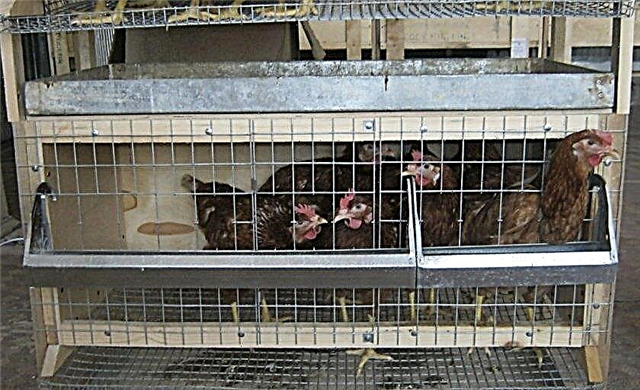 It is important not to overpopulate the cells, otherwise the birds will often get sick, they will be very uncomfortable, and it will be difficult for the owner to care.
It is important not to overpopulate the cells, otherwise the birds will often get sick, they will be very uncomfortable, and it will be difficult for the owner to care.
Norms of temperature and lighting
In the room where the cells are located, it should be controlled so that the temperature does not go beyond + 16-18 ° C. Raising the thermometer column above +30 ° C adversely affects productivity, above +36 ° C - it threatens heat stroke.
Humidity can be maintained at the level of 45-50%.
In the summer, a good air flow should be organized, which is ensured by high-quality ventilation in the room and the additional installation of fans near the cells.
For houses with an area of 6 square meters. m, natural ventilation will be sufficient - with the help of windows and windows. For rooms with large dimensions, a supply and exhaust system or a mechanical system will be needed. Lighting for chickens should come in sufficient quantity and evenly - shaded places should be excluded. This can be achieved using thermal incandescent lamps, energy-saving lamps, LED lamps.
Lighting for chickens should come in sufficient quantity and evenly - shaded places should be excluded. This can be achieved using thermal incandescent lamps, energy-saving lamps, LED lamps.
For stable and high egg production, it is necessary to organize daylight hours lasting 14-16 hours. During molting, it is reduced to 9 hours.
For every 2 square meters. m of the house requires 1 lamp with a 100 W incandescent lamp or a 12 W LED lamp. Indoors measuring 50 square meters. It will be enough to install 5 ordinary lamps of 40 watts each.
Important! Poor lighting threatens to reduce the productivity of laying hens, poor health, vitamin D deficiency, and increased aggression.
Cell Equipment
The feeder and drinker are placed on the front mesh wall. The feeder runs along the entire length and at a height of 10-15 cm from the floor. It is important to ensure that for 1 individual there are 8-10 cm of the feeder. Typically, feed equipment is made from food grade plastic or galvanized iron.
It is advisable to use a nipple drinker - this is the most convenient option for chickens. On average, one individual needs about 0.5 l of water per day to quench thirst and normal functioning of the body. For 5 chickens, 1 nipple is required. It is better to fill the water in the drinkers with the settled water. Nipple drinker At a distance of 10-15 cm below the cage there is a sliding tray made of zinc, which will collect bird excrement, feathers, fluff and other garbage. At the same distance, an egg chute is equipped. At its end there is a removable tray - eggs roll into it.
Nipple drinker At a distance of 10-15 cm below the cage there is a sliding tray made of zinc, which will collect bird excrement, feathers, fluff and other garbage. At the same distance, an egg chute is equipped. At its end there is a removable tray - eggs roll into it.
How to keep chickens in cages at home
When laying hens in a cage, feeding and care will be done in a special way.
Feeding
Since during cell breeding, birds cannot get their own food and replenish the body with the necessary vitamins and microelements, their feeding is significantly different from the ration of chickens kept in a free-range way. Such chickens are fed with premixes and compound feeds, it is possible with the addition of herbs and vegetables. If a normal diet is used, then eggshell or an additive containing calcium must be introduced into it. The daily menu should contain 72% carbohydrates, 15% protein, 2% vitamins, 6% fat, 3% fiber, 2% minerals. This can be achieved by compiling a ration of cereals, sunflower oilcake, vegetable and animal fats, calcium carbonate, vitamins, and salt. Mandatory introduction of meat and bone, fish, blood meal. Twice a week it is useful to give dairy products. Do not forget that to improve digestion, chickens need gravel.
If a normal diet is used, then eggshell or an additive containing calcium must be introduced into it. The daily menu should contain 72% carbohydrates, 15% protein, 2% vitamins, 6% fat, 3% fiber, 2% minerals. This can be achieved by compiling a ration of cereals, sunflower oilcake, vegetable and animal fats, calcium carbonate, vitamins, and salt. Mandatory introduction of meat and bone, fish, blood meal. Twice a week it is useful to give dairy products. Do not forget that to improve digestion, chickens need gravel.
Feeding of adult birds is carried out three times a day. The daily portion is 120-130 g.
Did you know? In Indonesia, hens that were completely blacked, including the comb, limbs, and even bones, were bred.
Care and cleaning
You must adhere to the following bird care and cage cleaning schedule:
- Once a day - cleaning of litter and garbage, washing the pan to collect excrement.
- Every 3 days - wiping the rods of the cage, equipment for feeding and water intake with a disinfectant.
- Every 14 days - processing disinfectant solutions of the insides of the cage and pallets with the extraction of birds.

Possible problems and solutions
The following health problems most often arise with cell living in birds: osteoporosis (a disease of the musculoskeletal system), a deficiency of vitamins (hypovitaminosis, rickets) and minerals. Consider the possible problems and solutions:
- Osteoporosis or cell paralysis develops due to a lack of calcium and vitamin D. It is accompanied by a violation of bone growth, exhaustion, dehydration. Prevention of this disease consists in tight control of the replenishment of the body with calcium and vitamin D with food, taking into account the age and productivity of the bird.
- Another disease that often develops in chickens in the cells due to a lack of vitamin D is rickets. It manifests itself by softening of the beak, claws, chest, weakness, exhaustion, poor appetite. Prevention will consist of introducing fish oil, fermented milk products, carrots, bone meal, spinach, shellfish into the feed.
- Vitamin A deficiency is manifested by stunted growth, bone deformation, and decreased productivity. To prevent it, chickens should have greens, carrots, nettles, and pumpkins in their diet.
- With a deficiency of B vitamins, problems with the nervous system appear. It is necessary to ensure that in the feed of the cell bird there is a sufficient amount of protein, bran, sprouted grain.
- With improperly mounted cages, bird injuries and egg loss are possible. This problem is solved by installing good cells with competent installation of all equipment.
- Every day, the host of caged birds should inspect the livestock for health conditions. If a sick individual is found, it must be quarantined immediately to prevent a massive outbreak of the disease.




